初中英语六种时态一览表
- 格式:doc
- 大小:22.50 KB
- 文档页数:4
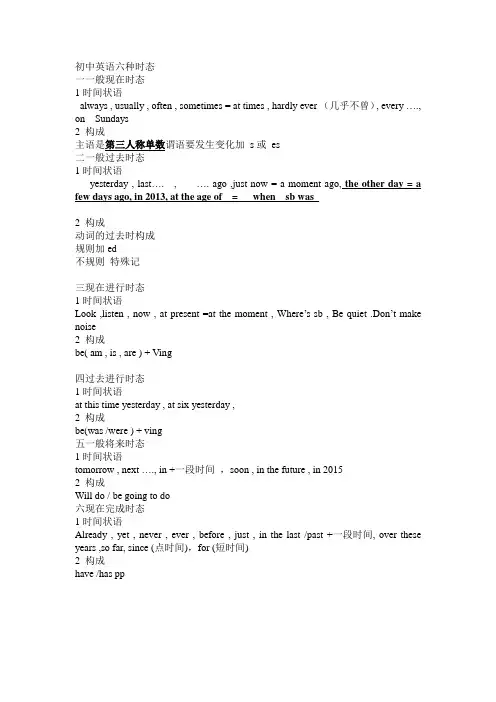
初中英语六种时态一一般现在时态1时间状语always , usually , often , sometimes = at times , hardly ever (几乎不曾), every …., on Sundays2 构成主语是第三人称单数谓语要发生变化加s或es二一般过去时态1时间状语yesterday , last…. , …. ago ,just now = a moment ago, the other day = a few days ago, in 2013, at the age of = when sb was2 构成动词的过去时构成规则加ed不规则特殊记三现在进行时态1时间状语Look ,listen , now , at present =at the moment , Where’s sb , Be quiet .Don’t make noise2 构成be( am , is , are ) + Ving四过去进行时态1时间状语at this time yesterday , at six yesterday ,2 构成be(was /were ) + ving五一般将来时态1时间状语tomorrow , next …., in +一段时间,soon , in the future , in 20152 构成Will do / be going to do六现在完成时态1时间状语Already , yet , never , ever , before , just , in the last /past +一段时间, over these years ,so far, since (点时间),for (短时间)2 构成have /has pp注意一时间状语1just现在完成时态just now = a moment ago 一般过去时态2 in the past /last 一般过去时态in a few years 一般将来时态in the last /past few years 现在完成时态3 the other day = a few years ago一般过去时态4 over (these) years现在完成时态5soon 一般将来时态6 at the age of = when sb was 一般过去时态7 so far =by now =until now 现在完成时态8 snice then现在完成时态Until then 过去完成时态二延续与非延续For /since 后面跟延续性词非延续词有完成时态I have bought a book .我买了一本书。
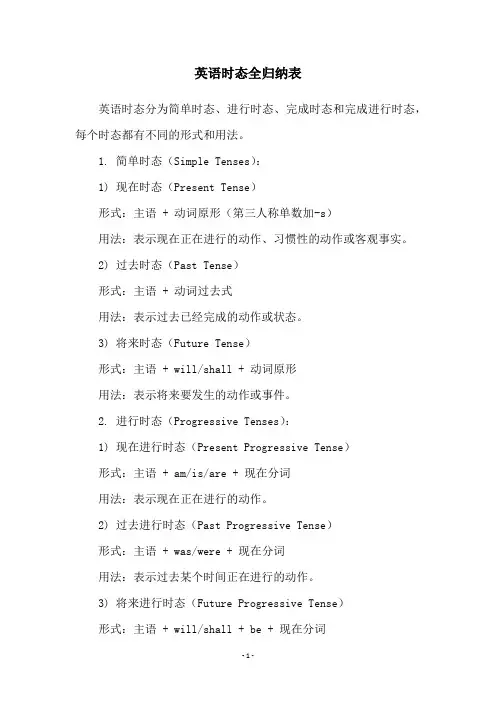
英语时态全归纳表英语时态分为简单时态、进行时态、完成时态和完成进行时态,每个时态都有不同的形式和用法。
1. 简单时态(Simple Tenses):1) 现在时态(Present Tense)形式:主语 + 动词原形(第三人称单数加-s)用法:表示现在正在进行的动作、习惯性的动作或客观事实。
2) 过去时态(Past Tense)形式:主语 + 动词过去式用法:表示过去已经完成的动作或状态。
3) 将来时态(Future Tense)形式:主语 + will/shall + 动词原形用法:表示将来要发生的动作或事件。
2. 进行时态(Progressive Tenses):1) 现在进行时态(Present Progressive Tense)形式:主语 + am/is/are + 现在分词用法:表示现在正在进行的动作。
2) 过去进行时态(Past Progressive Tense)形式:主语 + was/were + 现在分词用法:表示过去某个时间正在进行的动作。
3) 将来进行时态(Future Progressive Tense)形式:主语 + will/shall + be + 现在分词用法:表示将来某个时间正在进行的动作。
3. 完成时态(Perfect Tenses):1) 现在完成时态(Present Perfect Tense)形式:主语 + have/has + 过去分词用法:表示过去已经完成的动作对现在造成的影响。
2) 过去完成时态(Past Perfect Tense)形式:主语 + had + 过去分词用法:表示过去某个时间之前已经完成的动作。
3) 将来完成时态(Future Perfect Tense)形式:主语 + will/shall + have + 过去分词用法:表示将来某个时间之前已经完成的动作。
4. 完成进行时态(Perfect Progressive Tenses):1) 现在完成进行时态(Present Perfect Progressive Tense)形式:主语 + have/has + been + 现在分词用法:表示从过去某个时间一直到现在一直在进行的动作。
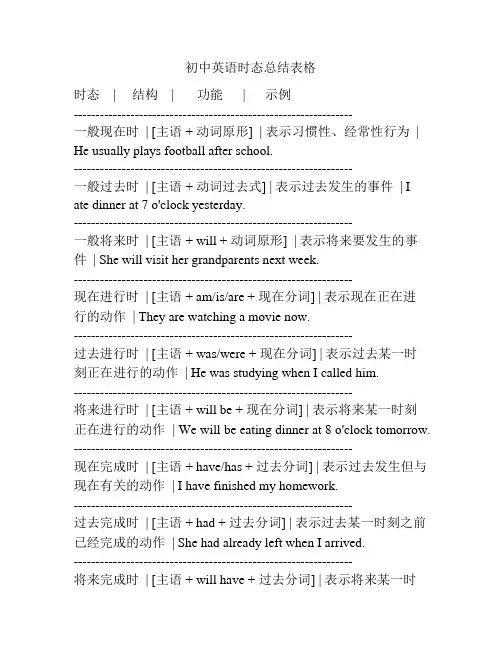
初中英语时态总结表格时态 | 结构 | 功能 | 示例----------------------------------------------------------------一般现在时 | [主语 + 动词原形] | 表示习惯性、经常性行为 | He usually plays football after school.----------------------------------------------------------------一般过去时 | [主语 + 动词过去式] | 表示过去发生的事件 | I ate dinner at 7 o'clock yesterday.----------------------------------------------------------------一般将来时 | [主语 + will + 动词原形] | 表示将来要发生的事件 | She will visit her grandparents next week.----------------------------------------------------------------现在进行时 | [主语 + am/is/are + 现在分词] | 表示现在正在进行的动作 | They are watching a movie now.----------------------------------------------------------------过去进行时 | [主语 + was/were + 现在分词] | 表示过去某一时刻正在进行的动作 | He was studying when I called him.----------------------------------------------------------------将来进行时 | [主语 + will be + 现在分词] | 表示将来某一时刻正在进行的动作 | We will be eating dinner at 8 o'clock tomorrow. ----------------------------------------------------------------现在完成时 | [主语 + have/has + 过去分词] | 表示过去发生但与现在有关的动作 | I have finished my homework.----------------------------------------------------------------过去完成时 | [主语 + had + 过去分词] | 表示过去某一时刻之前已经完成的动作 | She had already left when I arrived.----------------------------------------------------------------将来完成时 | [主语 + will have + 过去分词] | 表示将来某一时刻之前已经完成的动作 | By this time next year, we will have graduated from high school.----------------------------------------------------------------情态动词 | [情态动词 + 动词原形] | 表示能力、意愿、推测等 | She can swim very well.----------------------------------------------------------------。
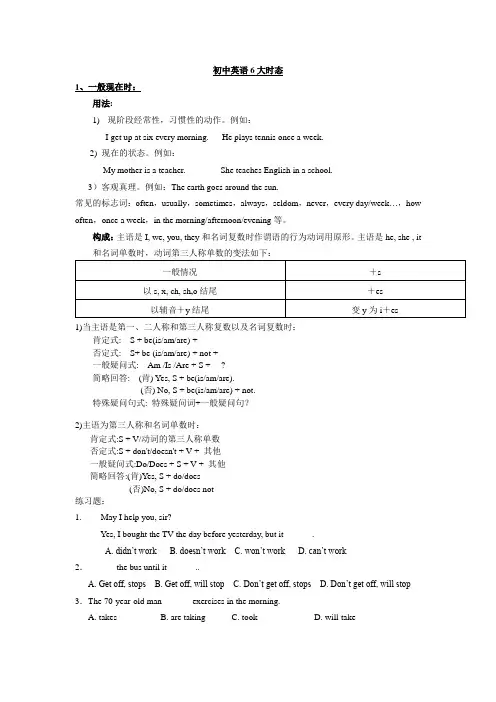
初中英语6大时态1、一般现在时:用法:1)现阶段经常性,习惯性的动作。
例如:I get up at six every morning. He plays tennis once a week.2) 现在的状态。
例如:My mother is a teacher. She teaches English in a school.3)客观真理。
例如:The earth goes around the sun.常见的标志词:often,usually,sometimes,always,seldom,never,every day/week…,how often,once a week,in the morning/afternoon/evening等。
构成:主语是I, we, you, they和名词复数时作谓语的行为动词用原形。
主语是he, she , it1)当主语是第一、二人称和第三人称复数以及名词复数时:肯定式: S + be(is/am/are) + ···否定式: S+ be (is/am/are) + not + ···一般疑问式: Am /Is /Are + S + ···?简略回答: (肯) Yes, S + be(is/am/are).(否) No, S + be(is/am/are) + not.特殊疑问句式: 特殊疑问词+一般疑问句?2)主语为第三人称和名词单数时:肯定式:S + V/动词的第三人称单数否定式:S + don't/doesn't + V + 其他一般疑问式:Do/Does + S + V + 其他简略回答:(肯)Yes, S + do/does(否)No, S + do/does not练习题:1.--- May I help you, sir?--- Yes, I bought the TV the day before yesterday, but it ______.A. didn’t workB. doesn’t workC. won’t workD. can’t work2.______ the bus until it ______..A. Get off, stopsB. Get off, will stopC. Don’t get off, stopsD. Don’t get off, will stop 3.The 70-year-old man ______ exercises in the morning.A. takesB. are takingC. tookD. will take用法:1).将要发生的动作。
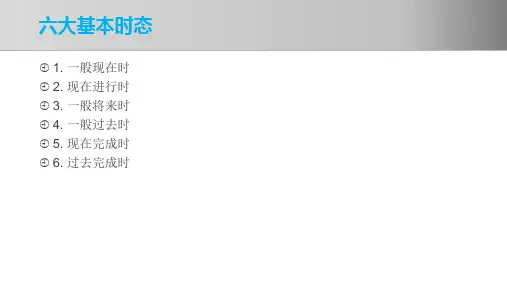
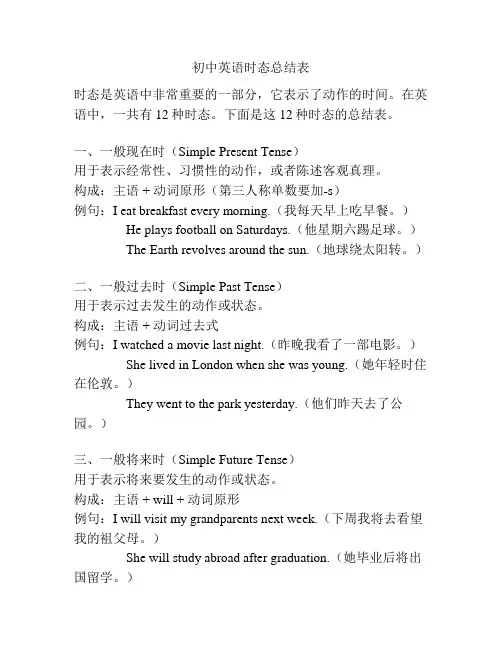
初中英语时态总结表时态是英语中非常重要的一部分,它表示了动作的时间。
在英语中,一共有12种时态。
下面是这12种时态的总结表。
一、一般现在时(Simple Present Tense)用于表示经常性、习惯性的动作,或者陈述客观真理。
构成:主语 + 动词原形(第三人称单数要加-s)例句:I eat breakfast every morning.(我每天早上吃早餐。
)He plays football on Saturdays.(他星期六踢足球。
)The Earth revolves around the sun.(地球绕太阳转。
)二、一般过去时(Simple Past Tense)用于表示过去发生的动作或状态。
构成:主语 + 动词过去式例句:I watched a movie last night.(昨晚我看了一部电影。
)She lived in London when she was young.(她年轻时住在伦敦。
)They went to the park yesterday.(他们昨天去了公园。
)三、一般将来时(Simple Future Tense)用于表示将来要发生的动作或状态。
构成:主语 + will + 动词原形例句:I will visit my grandparents next week.(下周我将去看望我的祖父母。
)She will study abroad after graduation.(她毕业后将出国留学。
)They will have a party on Friday.(他们将在星期五举行一个派对。
)四、现在进行时(Present Continuous Tense)用于表示现在正在进行的动作。
构成:主语 + am/is/are + 现在分词(-ing形式)例句:I am reading a book now.(我现在在读一本书。
)She is playing the piano at the moment.(她此刻正在弹钢琴。
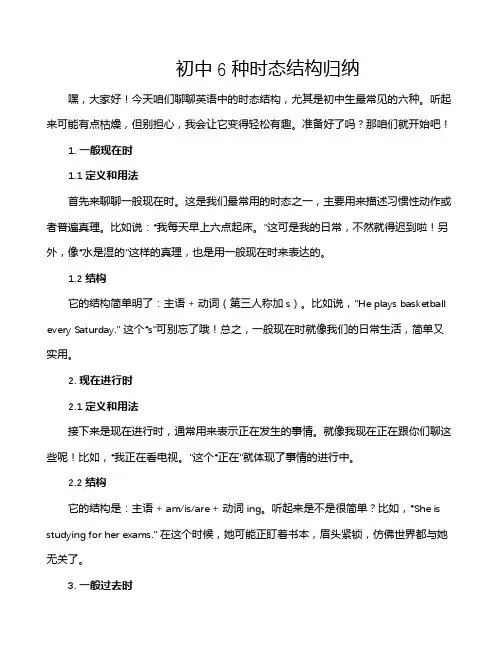
初中6种时态结构归纳嘿,大家好!今天咱们聊聊英语中的时态结构,尤其是初中生最常见的六种。
听起来可能有点枯燥,但别担心,我会让它变得轻松有趣。
准备好了吗?那咱们就开始吧!1. 一般现在时1.1 定义和用法首先来聊聊一般现在时。
这是我们最常用的时态之一,主要用来描述习惯性动作或者普遍真理。
比如说:“我每天早上六点起床。
”这可是我的日常,不然就得迟到啦!另外,像“水是湿的”这样的真理,也是用一般现在时来表达的。
1.2 结构它的结构简单明了:主语 + 动词(第三人称加s)。
比如说,"He plays basketball every Saturday." 这个“s”可别忘了哦!总之,一般现在时就像我们的日常生活,简单又实用。
2. 现在进行时2.1 定义和用法接下来是现在进行时,通常用来表示正在发生的事情。
就像我现在正在跟你们聊这些呢!比如,“我正在看电视。
”这个“正在”就体现了事情的进行中。
2.2 结构它的结构是:主语 + am/is/are + 动词ing。
听起来是不是很简单?比如,“She is studying for her exams.” 在这个时候,她可能正盯着书本,眉头紧锁,仿佛世界都与她无关了。
3. 一般过去时3.1 定义和用法好了,继续往下看,一般过去时来了!它主要用来描述过去发生的事情,像是“昨天我去超市了。
”回想起来,那时候我还买了好多零食呢,哈哈!这时态让我们能轻松分享过去的回忆。
3.2 结构结构也很简单:主语 + 动词过去式。
比如,“They visited their grandparents last weekend.” 想象一下,那种温馨的场景,真让人怀念!4. 过去进行时4.1 定义和用法过去进行时就像是在讲一个故事,它强调在过去某一时刻正在进行的动作。
比如,“我昨天晚上七点正在吃晚饭。
”想象一下,桌子上摆满了好吃的,那可真是一场美食盛宴!4.2 结构它的结构是:主语 + was/were + 动词ing。
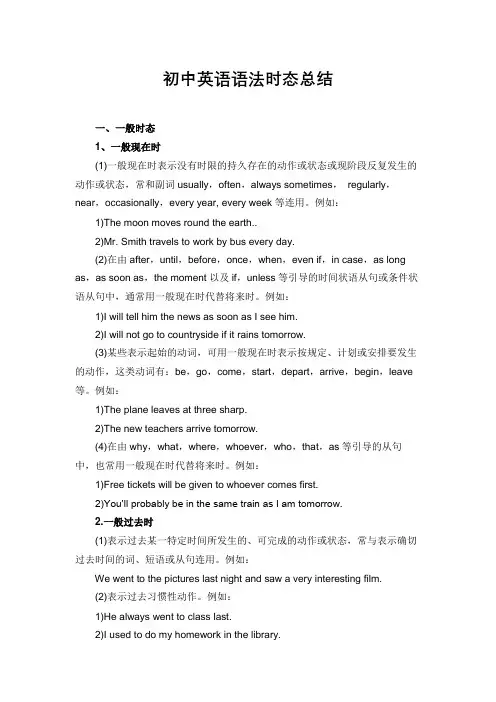
初中英语语法时态总结一、一般时态1、一般现在时(1)一般现在时表示没有时限的持久存在的动作或状态或现阶段反复发生的动作或状态,常和副词usually,often,always sometimes,regularly,near,occasionally,every year, every week等连用。
例如:1)The moon moves round the earth..2)Mr. Smith travels to work by bus every day.(2)在由after,until,before,once,when,even if,in case,as long as,as soon as,the moment以及if,unless等引导的时间状语从句或条件状语从句中,通常用一般现在时代替将来时。
例如:1)I will tell him the news as soon as I see him.2)I will not go to countryside if it rains tomorrow.(3)某些表示起始的动词,可用一般现在时表示按规定、计划或安排要发生的动作,这类动词有:be,go,come,start,depart,arrive,begin,leave 等。
例如:1)The plane leaves at three sharp.2)The new teachers arrive tomorrow.(4)在由why,what,where,whoever,who,that,as等引导的从句中,也常用一般现在时代替将来时。
例如:1)Free tickets will be given to whoever comes first.2)You’ll probably be in the same train as I am tomorrow.2.一般过去时(1)表示过去某一特定时间所发生的、可完成的动作或状态,常与表示确切过去时间的词、短语或从句连用。
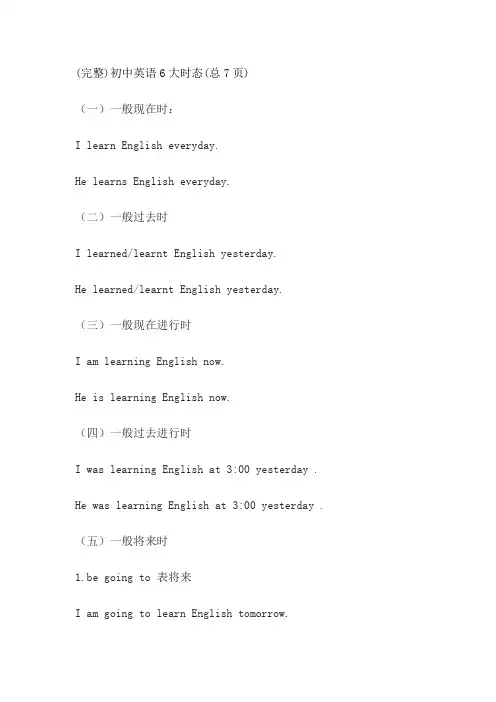
(完整)初中英语6大时态(总7页)(一)一般现在时:I learn English everyday.He learns English everyday.(二)一般过去时I learned/learnt English yesterday.He learned/learnt English yesterday.(三)一般现在进行时I am learning English now.He is learning English now.(四)一般过去进行时I was learning English at 3:00 yesterday . He was learning English at 3:00 yesterday . (五)一般将来时1.be going to 表将来I am going to learn English tomorrow.He is going to learn English tomorrow..Will表将来I will learn English tomorrow.He will learn English tomorrow.(六)一般现在完成时.Since➕时间点I have (already) learnt/learned English since I was five years old.He has (already) learnt/learned English since he was five years old..for ➕一段时间I have (already) learnt/learned English for ten years.He has (already) learnt/learned English for ten years. Tips:learn-learns(三单)-learnt/learned(过去式)-learnt/learned(过去分词)•谓语结构及使用情况快速记忆:一般现在时:主语 + do/does (习惯性,经常性或有规律地发生的事情)一般过去时:主语 + did (过去发生的事情)一般将来时:主语 + will do (未发生的事情)现在进行时:主语 + am/is/are doing (当下正在发生的事情)过去进行时:主语 + was/were doing (在过去某个特定时间点或时间段正在发生的事情)现在完成时:主语 + has/have done(第一种情况:无时间状语,有关键词already,just,ever,never,yet,before,so far;讲述对现在依然存在影响的事情。
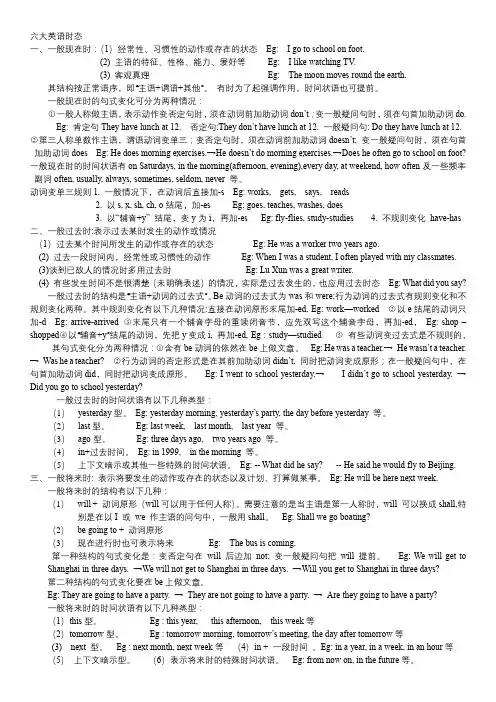
六大英语时态一、一般现在时:(1)经常性、习惯性的动作或存在的状态Eg: I go to school on foot.(2) 主语的特征、性格、能力、爱好等Eg: I like watching TV.(3) 客观真理Eg: The moon moves round the earth.其结构按正常语序,即“主语+谓语+其他”。
有时为了起强调作用,时间状语也可提前。
一般现在时的句式变化可分为两种情况:○1一般人称做主语,表示动作变否定句时,须在动词前加助动词don’t;变一般疑问句时,须在句首加助动词do.Eg: 肯定句They have lunch at 12. 否定句:They don’t have lunch at 12. 一般疑问句: Do they have lunch at 12.○2第三人称单数作主语,谓语动词变单三;变否定句时,须在动词前加助动词doesn’t; 变一般疑问句时,须在句首加助动词does Eg: He does morning exercises.→He doesn’t do morning exercises.→Does he often go to school on foot?一般现在时的时间状语有on Saturdays, in the morning(afternoon, evening),every day, at weekend, how often及一些频率副词often, usually, always, sometimes, seldom, never 等。
动词变单三规则1. 一般情况下,在动词后直接加-s Eg: works, gets, says, reads2. 以s, x, sh, ch, o结尾,加-es Eg: goes, teaches, washes, does3. 以“辅音+y” 结尾,变y为i,再加-es Eg: fly-flies, study-studies4. 不规则变化have-has二、一般过去时:表示过去某时发生的动作或情况(1)过去某个时间所发生的动作或存在的状态Eg: He was a worker two years ago.(2) 过去一段时间内,经常性或习惯性的动作Eg: When I was a student, I often played with my classmates.(3)谈到已故人的情况时多用过去时Eg: Lu Xun was a great writer.(4) 有些发生时间不是很清楚(未明确表述)的情况,实际是过去发生的,也应用过去时态Eg: What did you say?一般过去时的结构是“主语+动词的过去式”。
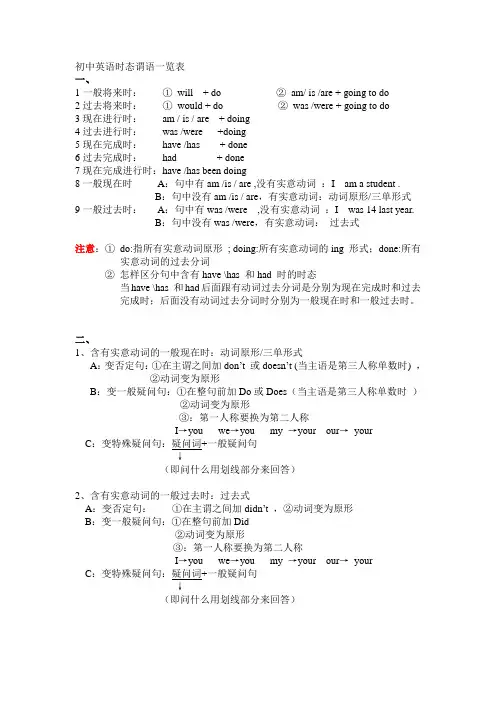
初中英语时态谓语一览表一、1一般将来时:①will + do ②am/ is /are + going to do2过去将来时:①would + do ②was /were + going to do3现在进行时:am / is / are + doing4过去进行时:was /were +doing5现在完成时:have /has + done6过去完成时:had + done7现在完成进行时:have /has been doing8一般现在时A:句中有am /is / are ,没有实意动词:I am a student .B:句中没有am /is / are,有实意动词:动词原形/三单形式9一般过去时:A:句中有was /were ,没有实意动词:I was 14 last year.B:句中没有was /were,有实意动词:过去式注意:①do:指所有实意动词原形; doing:所有实意动词的ing 形式;done:所有实意动词的过去分词②怎样区分句中含有have \has 和had 时的时态当have \has 和had后面跟有动词过去分词是分别为现在完成时和过去完成时;后面没有动词过去分词时分别为一般现在时和一般过去时。
二、1、含有实意动词的一般现在时:动词原形/三单形式A:变否定句:①在主谓之间加don’t 或doesn’t (当主语是第三人称单数时) ,②动词变为原形B:变一般疑问句:①在整句前加Do或Does(当主语是第三人称单数时)②动词变为原形③:第一人称要换为第二人称I→you we→you my →your our→yourC:变特殊疑问句:疑问词+一般疑问句↓(即问什么用划线部分来回答)2、含有实意动词的一般过去时:过去式A:变否定句:①在主谓之间加didn’t ,②动词变为原形B:变一般疑问句:①在整句前加Did②动词变为原形③:第一人称要换为第二人称I→you we→you my →your our→yourC:变特殊疑问句:疑问词+一般疑问句↓(即问什么用划线部分来回答)。
七八年级学过的英语时态
1.
现在进行时:表示现在正在进行的动作或状态。
例句:I am reading a book.(我正在读一本书。
)
2.
一般过去时:表示过去发生的动作或状态。
例句:She watched
a movie last night.(她昨晚看了一部电影。
)
3.
一般将来时:表示将来要发生的动作或状态。
例句:We will go to the park tomorrow.(我们明天要去公园。
)
4.
现在完成时:表示过去发生的动作对现在造成的影响或结果,或从过去开始一直持续到现在的动作或状态。
例句:He has finished his homework.(他已经完成了他的作业。
)
5.
过去进行时:表示过去某一时刻正在进行的动作。
例句:They were playing basketball at this time yesterday.(昨天这个时候他们正在打篮球。
)
6.
将来进行时:表示将来某一时刻正在进行的动作。
例句:I will be studying when you call me tomorrow.(明天你给我打电话的时候,我将会在学习。
)。
初中英语六种时态一览表六种时态一览表时态用法一般现在时一般过去时现在进行时过去进行时一般将来时现在完成时表示经常性发生的动表示过去某个时间发表示现在或现阶段正表示过去某时正在进表示将来某个时间要表示过去发生或者未作、习惯性动作或客生的动作或存在的状在进行或发生的动行的动作或存在的状发生的动作或存在的发生的事对现在造成观真理、科学事实等。
态。
作。
态。
状态。
的影响或结果。
频度副词:always,often,usually,sometimes,seldom,never;everyday,everyweek,every month,every year等thedaybefore yesterday,yesterday, last/yesterdaynight, lastweek,lastmonth, lastyear,lastterm;in/on+曩昔工夫;工夫+ago; just now, at the age of 5, one day, long long ago; once upon a timenow, at the moment, at thismoment,just now,look, listen, at present, these days, this weekjustthen,atthis momentyesterday, yesterdaymorning/ afternoon/evening,at thattime,thismorning,thewholemorning,alldayyesterday,from+时间数+to+时间数+lastnight, those days或以when, while引导的谓语动词是普通曩昔时的时间状语等。
was/were+动词的目前分词tomorrow;thedayalready, yet, just, ever, aftertomorrow;nextnever, before, for +时day/week/month/year/间段,since+时间点term;soon;inafewminutes;by+年份;in+工夫状语;inthefuture; in future工夫标记构成体式格局1.动词be(am/is/are) +表语…2.动词真相+…(主语是第三人称单数,动词也用第三人称单数)1.动词was/were+表语2.实义动词的过去式+…be(am/is/are) +动词的目前分词原形过去分词+…(shall用于第一人称) 2. be going to +动词原形疑句问型式1. Be +主语+…?2. Do/Does +主语+动词真相+…?1. Was/Were +主语+…?2. Did +主语+动词原形+…?Be+主语+动Was/Were+主语 1. Will/Shall +主语Have/Has+主语+过词的目前分词+动词的目前分词+动词真相+…?去分词+…?+…?+…?2.Be+主语+goingto+动词真相+…?1.主语+will/shall主语+ haven’t / hasn’t ++动词的目前分wasn’t (was not)/not+动词真相曩昔分词+…词+…weren’t(werenot)++…动词的目前分词2.主语+ be + not ++…goingto+动词原形+…变否1.主语+be+not1.主语+ was/were主语+ be + not主语+ +…+ not +…化定2.主语+don’t/doesn’t2.主语+ didn’t +。
初中英语八大时态一一般现在时1构成: 构成: do/does---------V(原形)或V+s/es2 重点用法: a 客观真理。
Birds fly.b 现阶段习惯性动作。
We have four classes everyday.c 表将来1)按时间表进行的, 飞机、火车、巴士的出发The train for Guangzhou leaves at 7:00.2) 时间状语从句(till, until, when, as soon as等引导), 条件状语从句(unless, if引导)中表将来。
(主从) If it rains tomorrow, we will have to stay at home.3 标志词: 频率副词(often, everyday, on Sundays等)二一般过去时1 构成: 动词过去式did----------V-ed(不规则动词表的第二列)2 重点用法: 过去的事情He always went to work by bus last year.3 标志词: I worked here ten years ago.以及表示过去的时间( year, yesterday…) I got sick yesterday.三一般将来时1 构成will/shall do 或am/is/are going to do ----------will+ V原形2 重点用法: 将来的事情I will tell him about it.3 标志词: in+ 一段时间I will be back in an hour.以及表示将来的时间(week, tomorrow…)四过去将来时1 构成would do 或was/were going to do---------would+V(原形)2 重点用法从过去某一时刻看将来要发生的事情。
特别是宾语从句红, 主句said, wanted to know动词的过去式时, 宾语从句中, 表示过去的将来。
初中英语6大时态初中英语时态是英语语法中的重要部分,也是学习英语的基础之一。
以下是初中英语常见的六大时态:一、现在进行时现在进行时表示现在正在进行的动作或存在的状态。
其构成形式是be动词(am/is/are)+动词的现在分词形式。
例如:I am studying now. 我正在学习。
二、过去进行时过去进行时表示过去某一时刻正在进行的动作或存在的状态。
其构成形式是be动词的过去式(was/were)+动词的现在分词形式。
例如:We were watching TV at 8 o'clock yesterday evening. 昨天晚上八点钟我们在看电视。
三、一般现在时一般现在时表示通常或反复发生的动作或存在的状态。
其构成形式是主语+动词+(宾语)。
例如:We go to school every morning. 我们每天早上都去上学。
四、一般过去时一般过去时表示过去某个时间发生的动作或存在的状态。
其构成形式是主语+动词的过去式+(宾语)。
例如:We went to the park yesterday. 昨天我们去了公园。
五、一般将来时一般将来时表示将来要发生的动作或存在的状态。
其构成形式是主语+will/shall+动词原形+(宾语)。
例如:We will finish our homework tomorrow. 我们明天将完成我们的作业。
六、过去将来时过去将来时表示过去某一时刻将要发生的动作或存在的状态。
其构成形式是主语+would+动词原形+(宾语)。
例如:He said he would come to see me the next day. 他说他第二天会来看我。
初中英语所有时态1.一般现在时(do/does; is/am/are)①表示现在的情况、状态或特征。
例:He is a student.他是一个学生。
②表示经常性、习惯性动作。
例:He always helps others.他总是帮助别人。
③客观事实和普遍真理。
例:The earth moves the sun.地球绕着太阳转。
④表示一个按规定、计划或安排要发生的动作。
仅限于某些表示“来、去、动、停、开始、结束、继续”等的动词,可以与表示未来时间的状语搭配使用。
常见的用法是:飞机、火车、轮船、汽车等定期定点运行的交通方式。
例:The next train leaves at 3 o'clock this afternoon.下一趟火车今天下午3点开车。
⑤在时间、条件和让步状语从句中经常用一般现在(有时也用现在完成时)表示将的来事情。
(即:主将从现原则)例:I will call you as soon as I arrive at the airport.我一到机场就会给你打电话。
When you have finished the report, I will have waited for about 3 hours.等你完成这份报告的时候,我就已经等了将近3个小时了。
2. 现在进行时(am/is/are doing)①表示此时此刻正在发生的事情。
例:He is listning to the music now.他现在正在听音乐。
②表示目前一段时间内一直在做的事情,但不一定此时此刻正在做。
例:I am studying computer this term.这个学期我一直在学习计算机。
③现在进行时可以表示将来的含义。
瞬时动词的进行一定表将来。
例:I am leaving.我要离开了。
持续动词的进行只有有将来的时间状语或有将来语境中才表将来。
例:I am travelling next month.下个月我要去旅行。
六种时态一览表时态一般现在时一般过去时现在进行时过去进行时一般将来时现在完成时用法时间标志构成方式表示经常性发生的动表示过去某个时间发表示现在或现阶段正表示过去某时正在进表示将来某个时间要作、习惯性动作或客生的动作或存在的状在进行或发生的动行的动作或存在的状发生的动作或存在的观真理、科学事实等。
态。
作。
态。
状态。
频度副词: always,the day before now, at the moment, at just then,at this tomorrow ; the dayoften , usually ,yesterday,yesterday,this moment, just moment yesterday, after tomorrow;nextsometimes,seldom,last/yesterday night,now,look, listen, at yesterday morning/day/week/month/year/never;everyday,every last week, last month,present, these days,afternoon/evening, at term; soon; in a fewweek, every month, last year,last term;this week that time,this minutes; by+ 年份 ;every year 等in/on+ 过去时间 ;时间morning,the whole in+时间状语; in the+ago; just now, at the morning,all day future; in futureage of 5, one day, long yesterday, from+ 时间long ago; once upon a数 +to+ 时间数 +lasttime night, those days 或以when, while 引导的谓语动词是一般过去时的时间状语等。